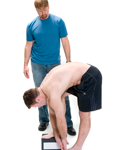We rely on movement. Functional movement comes in many different forms and isn’t something that just elite athletes need to worry about. Every day we need to bend down and pick up our child, or reach to the top cupboard, or do our fitness routine at the gym. The Selective Functional Movement Assessment (SFMA) goal is to have people move well and move often.
My name is Stephanie and I am a Physiotherapist at Pivotal Physiotherapy. I recently took a course and became certified to perform the Selective Functional Movement Assessment and I am going to further explain what it is and share some of its awesome benefits with you.
The SFMA assesses the quality of movements and identifies movements that cause you pain. It begins with a set of seven full-body movement screens which get scored and further broken down. They are simple every day movements such as: the ability to look over your shoulder, balance on one leg, or perform a squat. The breakdowns allow a clinician to pinpoint the root cause of the dysfunctional movement pattern and/or cause of the pain. The dysfunction can be categorized as either a mobility problem ie) joint dysfunction or tissue length/extensibility issue, or a stability/motor control problem. Let’s take a closer look at one of the seven movements called the ‘multi-segmental flexion’ where a patient stands with their feet together, and bends down to touch their toes. As seen below:

You’ve probably said or heard someone say ‘I can’t touch my toes because I have tight hamstrings.’ This is one possibility, but there are many other muscles and joints involved when bending forward. It requires core and hip strength to balance and weight shift, as well as good motion in the spine and hips. Through a series of breakout tests and movements the clinician can determine if any of these areas are causing the problem, and yes, if the hamstrings are involved.
As mentioned previously, the SFMA movements can be applied to people from all walks of life. For example, we require Multi-Segmental Flexion to perform tasks such as: bending down to pull weeds, putting on your shoes, or performing a deadlift at the gym.
The SFMA can be used to assess pain with this:

To pain with this:

To pain with this:

We move in many different ways to complete our daily tasks, and we don’t have to have pain with those movements. The SFMA can be applied to nearly anyone with pain. As a patient you can expect a thorough assessment of your functional movement and individualized treatment plan to get you back to moving well and pain free. Stop putting up with your pain today and book a SFMA at Pivotal today!
Stephanie Jones MScPT
